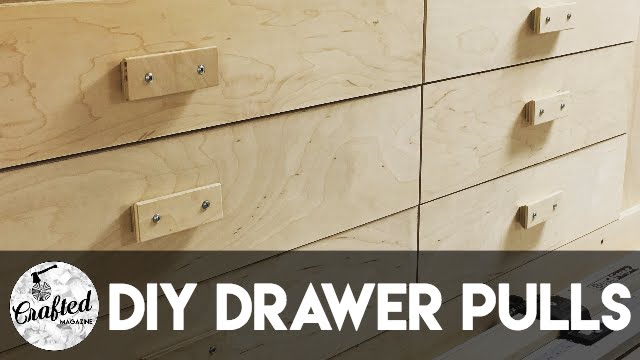Hey there! In this article titled “How to Make DIY Drawer Pulls”, you’ll learn all about crafting your own drawer or cabinet pulls. The video featured is by Crafted Workshop, where Johnny Brook takes you through the process step by step. The article begins by outlining the necessary tools you’ll need for this project. Then, it breaks down the construction process from setting the miter angle on a table saw, making the cuts on the pieces, rounding over the edges, marking the hole placements, drilling the holes, and attaching the drawer pulls. Whether you’re a woodworking enthusiast or just looking to add some personal touch to your furniture, this DIY project is a great way to create unique drawer pulls for your shop or office furniture.

This image is property of i.ytimg.com.
Table Saw Setup
Setting the miter angle
To begin making DIY drawer pulls, you’ll need to set the miter angle on your table saw to 25 degrees. This angle will create the desired shape for the pulls. It’s important to set the angle accurately to ensure consistent results. Once the angle is set, you can proceed with making the first cut.
Making the first cut
With the miter angle set, it’s time to make the first cut on one side of the drawer pull pieces. Make sure that the side you want to be facing out is facing up on the table saw. This will ensure that the pretty side of the wood is visible when the pulls are installed. Take your time to make precise cuts, ensuring that the angle is cut accurately.
Dimensions and Angles
Determining the dimensions
The final dimensions of the drawer pulls will be 4.5 inches by 1.5 inches. However, it’s not important to focus on the width at this stage. The initial step is to cut the angle on one side of each piece, which will create the desired shape for the pulls. Experiment with different sizes to find what feels comfortable in your hands.
Cutting the angle on the other side
After cutting the angle on one side of all the pieces, it’s time to cut the angle on the other side. Turn the pieces 180 degrees horizontally and cut the 25-degree angle into the other side. These two cuts will create the angles on the long edges of the drawer pulls. Take care to maintain consistency in the angle and ensure accurate cuts.
Crosscutting and Safety
Crosscutting the minors
To create the shorter edges of the drawer pulls, crosscut them using a miter gauge or stock miter gauge. Use a 90-degree crosscut setup, placing the miter gauge in the miter slot to the left side of the blade. Flip the drawer pulls over so that the back side is facing up and make your cuts. The 25-degree angle should be cut into one side of the pull.
Using safety precautions
When crosscutting the drawer pulls, it’s important to prioritize safety. Wear safety glasses to protect your eyes from any potential kickback. Although the small pieces don’t have enough force to cause significant harm, it’s always better to be safe. Take caution and follow safety guidelines while working with power tools.
Creating the Stops
Setting up a stop block
To ensure consistent lengths for the pulls, set up a stop block at 4.5 inches. If you don’t have a fancy miter gauge, you can use a piece of scrap wood and a clamp to create a makeshift stop block on your stock miter gauge. Avoid using your table saw fence for these cuts, as it can increase the risk of kickback.
Crosscutting the drawer poles
Once the stop block is in place, make the same crosscut on the other side of all the drawer pulls. This will result in a consistent length for each pull. By completing this step, you’ll have achieved the desired shape and dimensions for the pulls.

This image is property of images.unsplash.com.
Round Over and Sanding
Rounding over the edges
To add a smooth and finished look to the drawer pulls, round over the edges. Use an eighth-inch radius round over bit on a router table. This step can be challenging with a handheld router, as there isn’t much surface area to support the router. If you don’t have a router table, you can achieve a similar result by sanding the edges.
Sanding the edges
After rounding over the edges, sand them to ensure a clean and polished finish. Use a contour sanding grip with 120-grit sandpaper to remove any rough edges or splintered wood. This step will give the drawer pulls a professional appearance and make them comfortable to handle.
Marking the Center Line
Using a marking gauge
To mark the center line on the front of the drawer pulls, use a marking gauge. This tool allows for precise measurements. However, if you don’t have a marking gauge, you can use calipers or a combination square and pencil to create the center lines. These lines will later be used for drilling holes in the pulls.
Alternative marking methods
If you don’t have access to a marking gauge or measuring tools, there are alternative methods for marking the center lines. For example, you can use the Rockler drawer pull jig system, which includes a centerline guide. This system simplifies the process by providing pre-made markings for hole placement.

This image is property of images.unsplash.com.
Drilling Holes in Drawer Pulls
Using the Rockler jig system
To drill holes in the drawer pulls, use the Rockler jig system. Align the centerline of the jig with the horizontal line on the drawer pull, corresponding to the desired hole placement. Mark the hole locations with a center punch included with the jig system. This ensures that the holes are accurately placed for attaching the pulls.
Choosing the right drill bit size
When drilling the holes, it’s crucial to select the appropriate drill bit size. The size will depend on the screws you plan to use for attaching the drawer pulls. For example, if you’re using number 10 screws, a 7/64th inch drill bit should be suitable. Choose a size that matches the screw shaft, ensuring a secure and tight fit.
Drilling Holes in Drawer Fronts
Using the jig template
To attach the drawer pulls to the drawer fronts, use the jig template again. Line up the centerline of the jig with the vertical center of the drawer and align the holes that correspond to the drawer pulls’ placement. Use a center punch to mark the hole locations on the drawer fronts. This will ensure precise and consistent hole placement.
Attaching hardware from the inside
If you prefer a more concealed look, you can attach the hardware from the inside of the drawer. To do this, mark the center lines on the back of the drawer pulls instead of the front. Drill holes in the pulls that don’t go all the way through, allowing you to attach the screws from inside the drawer. This method keeps the hardware hidden from view.

This image is property of images.unsplash.com.
Finalizing the Project
Installing the drawer pulls
Once you have completed all the necessary steps, it’s time to install the drawer pulls on your furniture or shop project. Align the holes in the drawer pulls with the holes drilled in the drawer fronts, ensuring a secure fit. Use the appropriate screws to attach the pulls and tighten them firmly.
Considering support on Patreon
If you found this DIY project helpful and enjoyable, consider supporting Crafted Workshop on Patreon. Financial support is essential for running and creating content for Crafted Workshop. With your help, Crafted Workshop can continue providing woodworking, metalworking, and making content. Support on Patreon can make it possible to dedicate more time and resources to producing high-quality projects and videos.
Conclusion
Enjoying the project
Congratulations on completing your DIY drawer pulls! By following the steps outlined in this article, you have created custom and functional pulls for your shop project or furniture. Enjoy the satisfaction of seeing your hard work come to life by using these pulls in your everyday life.
Requesting support on YouTube and Patreon
If you enjoyed this project and want to see more woodworking, metalworking, and making content, consider subscribing to Crafted Workshop’s YouTube channel. By subscribing, you’ll stay updated with new content every Monday and weekly vlogs every Thursday. Additionally, show support by considering a contribution on Patreon. Even a small monthly donation can make a significant impact in supporting Crafted Workshop’s continued growth and production of high-quality content.









